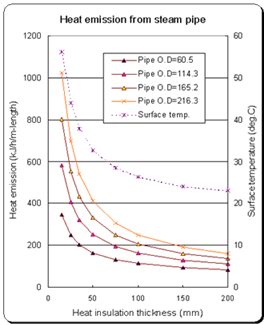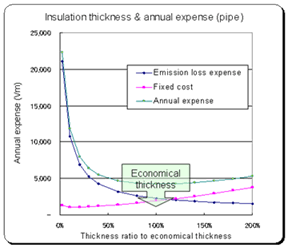Heat Insulation
|
 |
 |
|
|
Remarks: Steam temperature=183°C Room temperature=20°C Heat transfer factor, inside=10,000 kJ/h/m2/°C Surface emissibity=0.6 Insulation material=Rockwool blanket Economical thickness |
| AEEC Home | Training Index | Index | Top | Previous | Next |
| ECCJ / Text | India |
Criteria for exhaust gas temperature (the Law Concerning Rational Use of Energy) |
||||||||||||||||||||||||||||||||
Criteria for boilers, standard / target exhaust gas temperature
|
||||||||||||||||||||||||||||||||
Heat Insulation |
||||
|
Criteria for factories (The Energy Conservation Law) |
|
The "criterion" should be observed to the extent economically and technically possible. The "target" is the objective to pursue to achieve a reduction of energy unit consumption of 1 (one) percent per year (average). Subjects of criteria (matters concerning standards)
Quantitatively specified item of criteria (standard value, target value)
|
Guidelines by The Law |
||
|
| 7/16 Next |
| AEEC Home | Training Index | Index | Top | Previous | Next |